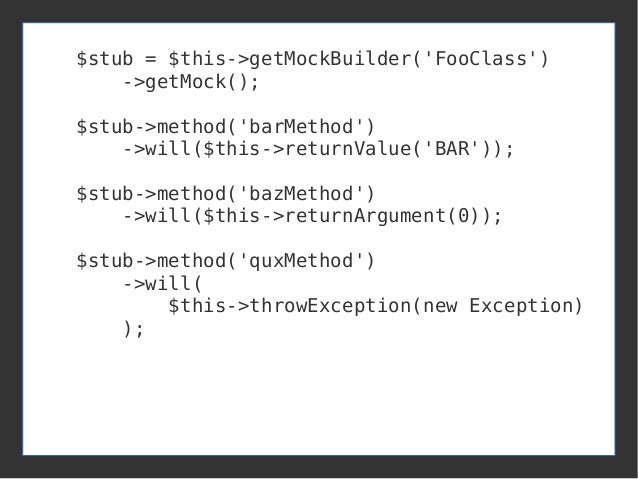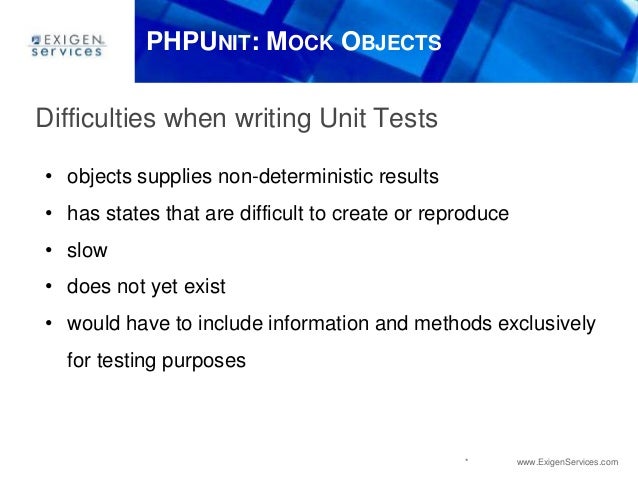
#Phpunit mocks vs stubs code
Please note this code is overly simplistic for demonstration purposes. For simplicity, it has only two methods, one that actually prompts the user (which would be used by all the other methods) and the one we are going to test, which prompts and filters out only yes and no answers. Let's start with a class that prompts the user. Mocks are objects pre-programmed with expectations that form a specification of the calls they are expected to receive. You can stub out those sections of code, allowing the rest of the code to be tested. I know stubs verify state and the mocks verify behavior. The difference is between them.Sometimes there are sections of code that are difficult to test, such as accessing a database, or interacting with the user. Repetition, making it harder to compare two tests side-by-side to see what we can mock out a function to return values in a way that makes a related piece of.

The initialization code will also contain a lot of A mock is a piece of dummy code that helps your tests run in a way that isolates specific functionality. And the more dependencies a class has, the Mocks also perform no calculations, but are used to follow the. Stubs perform no calculations and always return a predictable value (eg NULL, or a predefined value). A continuación, llamamos al método toArray () en la respuesta, e iteramos sobre cada incidencia para ver si el título contiene. A cambio, obtenemos un ResponseInterface que contiene una matriz de incidencias del repositorio dino-park. If you include the test double setup in the test body, your test will get In short, these are dummy classes which provide exactly the same interface as the class they are replacing for the test. En primer lugar, el constructor requiere un objeto HttpClientInterface que utilizamos para llamar a GitHub. simulate returning different values (fakes) PHPUnit provides methods that are used to automatically create objects that will replace the original object in our test.do nothing except accept method calls (stubs) The createStub (type), createMock (type), and getMockBuilder (type) methods provided by PHPUnit can be used in a test to automatically generate an object that can act as a test double for the specified original type (interface or class name).You might need to replace each dependency with different types of test doubles to.You need to set up the dependencies in each test Mocks also perform no calculations, but are used to follow the execution path of the calling code.When unit-testing classes you replace some or all injectedĭependencies with test doubles, to ensure you’re only testing theĬode in the class and to be able to cover all code paths in the class. What’s the problem we’re trying to solve? Stubs and mocks are both dummy objects for testing, while stubs only implement a pre-programmed response, mocks also pre-program specific expectations. Using a builder pattern with a fluent interface and using named parameters

Short and expressive as possible: Using properties in the test class, (also known as “mocks”) to your tested class, while keeping the tests as This articles explores three ways to provide test doubles Mocks are a type of test double which make assertions on how the object will be used.

The more dependencies a class has, the harder it becomes to initialize in If youve written a unit test, youve (almost definitely) written mocks.


 0 kommentar(er)
0 kommentar(er)
